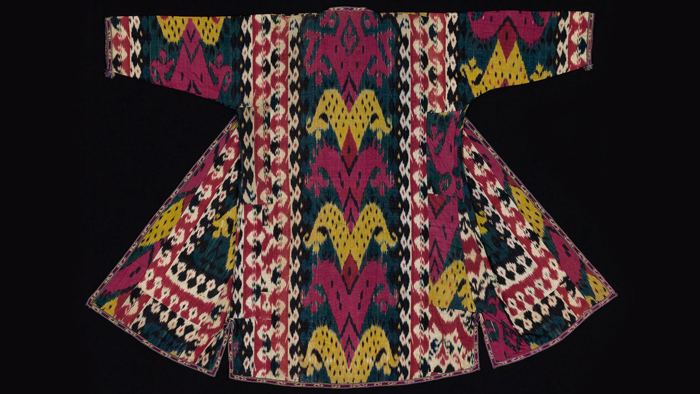
27 Oct Abrabandi Ikat: Central Asia’s Most Precious Textile
Although ikat weaving has emerged from different parts of the world, with its original source still unclear, it is the silk ikat from Central Asia, defined as abrabandi, meaning “bound-cloud”, that is certainly the most striking. These ikats are made using a resist dye technique whereby the warp yarns (vertical threads) are bound and hand-dyed before being woven with the weft yarns (horizontal threads). Such binding and dying processes are extremely complex and the more colours and more complex the patterns are, the more admired the abrabandi robe is. After all, the attention to detail and finely tuned skills of abrabandi masters is suitably couture. Time-honoured processes are highly valued and continue to be taught to young apprentices.
Here are 8 interesting facts on Central Asia’s most precious textile!
- The cradle of abrabandi weaving traditions is the Fergana Valley, where patterns and techniques have been developed and refined over generations alongside motifs stretching back to ancient times.
- The silk used to make the most expensive abrabandi robes was first brought to the region from China. As the Fergana valley sat at the heart of the famed Silk Road, and was a direct route between China and the Roman world, it was introduced to Chinese silk at a very early period. The Chinese kept their silkworms and the process of reeling a close guarded secret, however, over time, the Chinese prohibition on the export of silkworms became ineffectual; they were no longer able to hide their highly sought-after textile methods. Bukhara became the centre of silk production, and was later passed to the city of Margilan, where Central Asian silks were traded to Baghdad, Kashgar, Khorasan, Egypt and Greece along the great Silk Road.
- It was in fact Central Asia’s women who mastered the art of silk weaving. They learnt the ancient yet subtle art of unwinding cocoons and began using the finest threads in weaving. The process was time-consuming and an incredibly complex skill that transformed the material into a jewel, which was often substituted for money.
- In the past, it took a number of skilled artisans to produce a silk abrabandi The chizmachi, designer, who carried up to forty traditional patterns in their heads, first drew their designs using a stick dipped in soot, tracing the movement of the design and showing where the threads were to be tied. According to the chizmachi’s design, the abrbandchi, artist, then tied bunches of threads together, and passed them onto the kukchi, dyer, who worked with up to seven different dyes in order to get the colour right for each thread. The threads were then unwounded, straightened and stretched, ready to be weaved by the ‘cloud-tiers’.
- Once abrabandi ikats were woven and taken off the loom, they were always treated with a coat of egg white and a paste of glue, which not only strengthened the fabric but also rendered it water-resistant!
- The rich colours on abrabandi ikats were obtained from all-natural resources; the colour yellow derived from saffron, gold from the dried rind of pomegranates, red from crushed cochineal insects, brown from walnut husk and blue from the indigo plant imported from the Indian subcontinent. However, the recipes for such dyes were closely held secrets of Jewish merchants and artisans, who lived in Central Asia’s oasis cities of Bukhara, Tashkent and Samarkand and strived during the artful era of Timur (14th century).
- From the 12th century onwards, abrabandi robes became highly esteemed icons of status and were worn by both Central Asian men and women during special festivities. They were also used as dowries, to wrap newborn babies and were gifted to honour guests and foreign emissaries in courts – their quality reflecting the status of the recipient. Wealthy Central Asian merchants also adorned themselves with up to ten layers of abrabandi robes, displaying their wealth and status in a most flamboyant manner.
- The true masterpiece of Central Asian abrabandi weaving was the silk Khan Atlas. Originating from the city of Margilan, it was revered for its beauty, unique pattern and noble opalescence and became the defining symbol of Central Asian territories, its colourful patterns encrypting the philosophy of abrabandi masters and their artistic taste.
